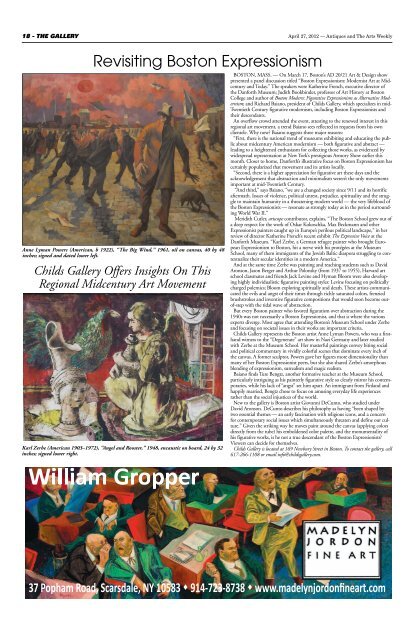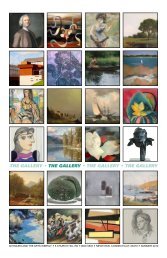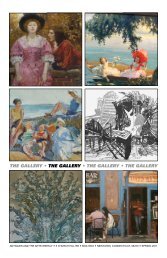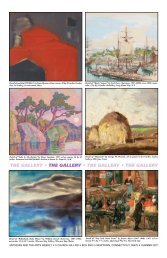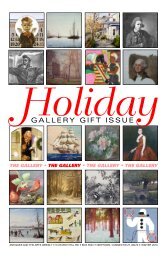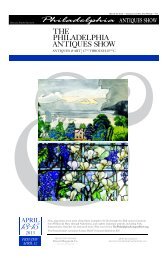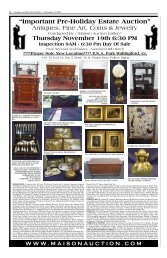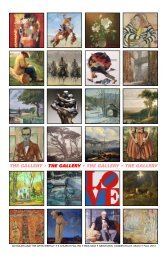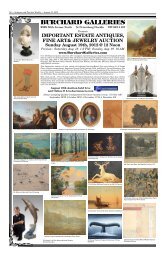the gallery the gallery the gallery the gallery - Antiques and the Arts
the gallery the gallery the gallery the gallery - Antiques and the Arts
the gallery the gallery the gallery the gallery - Antiques and the Arts
Create successful ePaper yourself
Turn your PDF publications into a flip-book with our unique Google optimized e-Paper software.
18 - THE GALLERY April 27, 2012 — <strong>Antiques</strong> <strong>and</strong> The <strong>Arts</strong> Weekly<br />
Revisiting Boston Expressionism<br />
Anne Lyman Powers (American, b 1922), “The Big Wind,” 1961, oil on canvas, 40 by 48<br />
inches; signed <strong>and</strong> dated lower left.<br />
Childs Gallery Offers Insights On This<br />
Regional Midcentury Art Movement<br />
Karl Zerbe (American 1903–1972), “Angel <strong>and</strong> Rooster,” 1948, encaustic on board, 24 by 32<br />
inches; signed lower right.<br />
BOSTON, MASS. — On March 17, Boston’s AD 20/21 Art & Design show<br />
presented a panel discussion titled “Boston Expressionism: Modernist Art at Midcentury<br />
<strong>and</strong> Today.” The speakers were Ka<strong>the</strong>rine French, executive director of<br />
<strong>the</strong> Danforth Museum; Judith Bookbinder, professor of Art History at Boston<br />
College <strong>and</strong> author of Boston Modern: Figurative Expressionism as Alternative Modernism;<br />
<strong>and</strong> Richard Baiano, president of Childs Gallery, which specializes in mid-<br />
Twentieth Century figurative modernism, including Boston Expressionists <strong>and</strong><br />
<strong>the</strong>ir descendants.<br />
An overflow crowd attended <strong>the</strong> event, attesting to <strong>the</strong> renewed interest in this<br />
regional art movement, a trend Baiano sees reflected in requests from his own<br />
clientele. Why now? Baiano suggests three major reasons:<br />
“First, <strong>the</strong>re is <strong>the</strong> national trend of museums exhibiting <strong>and</strong> educating <strong>the</strong> public<br />
about midcentury American modernism — both figurative <strong>and</strong> abstract —<br />
leading to a heightened enthusiasm for collecting those works, as evidenced by<br />
widespread representation at New York’s prestigious Armory Show earlier this<br />
month. Closer to home, Danforth’s illustrative focus on Boston Expressionism has<br />
certainly popularized that movement <strong>and</strong> its artists locally.<br />
“Second, <strong>the</strong>re is a higher appreciation for figurative art <strong>the</strong>se days <strong>and</strong> <strong>the</strong><br />
acknowledgement that abstraction <strong>and</strong> minimalism weren’t <strong>the</strong> only movements<br />
important at mid-Twentieth Century.<br />
“And third,” says Baiano, “we are a changed society since 9/11 <strong>and</strong> its horrific<br />
aftermath. Issues of violence, political unrest, prejudice, spirituality <strong>and</strong> <strong>the</strong> struggle<br />
to maintain humanity in a threatening modern world — <strong>the</strong> very lifeblood of<br />
<strong>the</strong> Boston Expressionists — resonate as strongly today as in <strong>the</strong> period surrounding<br />
World War II.”<br />
Meridith Cutler, artscope contributor, explains, “The Boston School grew out of<br />
a deep respect for <strong>the</strong> work of Oskar Kokoschka, Max Beckmann <strong>and</strong> o<strong>the</strong>r<br />
Expressionist painters caught up in Europe’s perilous political l<strong>and</strong>scape,” in her<br />
review of director Ka<strong>the</strong>rine French’s recent exhibit The Expressive Voice at <strong>the</strong><br />
Danforth Museum. “Karl Zerbe, a German refugee painter who brought European<br />
Expressionism to Boston, hit a nerve with his protégées at <strong>the</strong> Museum<br />
School, many of <strong>the</strong>m immigrants of <strong>the</strong> Jewish Baltic diaspora struggling to contextualize<br />
<strong>the</strong>ir secular identities in a modern America.”<br />
And at <strong>the</strong> same time Zerbe was painting <strong>and</strong> teaching students such as David<br />
Aronson, Jason Berger <strong>and</strong> Arthur Polonsky (from 1937 to 1955), Harvard art<br />
school classmates <strong>and</strong> friends Jack Levine <strong>and</strong> Hyman Bloom were also developing<br />
highly individualistic figurative painting styles: Levine focusing on politically<br />
charged polemics; Bloom exploring spiritually <strong>and</strong> death. These artists communicated<br />
<strong>the</strong> evils <strong>and</strong> angst of <strong>the</strong>ir times through richly saturated colors, frenzied<br />
brushstrokes <strong>and</strong> inventive figurative compositions that would soon become outof-step<br />
with <strong>the</strong> tidal wave of abstraction.<br />
But every Boston painter who favored figuratism over abstraction during <strong>the</strong><br />
1940s was not necessarily a Boston Expressionist, <strong>and</strong> that is where <strong>the</strong> various<br />
experts diverge. Most agree that attending Boston’s Museum School under Zerbe<br />
<strong>and</strong> focusing on societal issues in <strong>the</strong>ir works are important criteria.<br />
Childs Gallery represents <strong>the</strong> Boston artist Anne Lyman Powers, who was a firsth<strong>and</strong><br />
witness to <strong>the</strong> “Degenerate” art show in Nazi Germany <strong>and</strong> later studied<br />
with Zerbe at <strong>the</strong> Museum School. Her masterful paintings convey biting social<br />
<strong>and</strong> political commentary in vividly colorful scenes that dominate every inch of<br />
<strong>the</strong> canvas. A former sculptor, Powers gave her figures more dimensionality than<br />
many of her Boston Expressionist peers, but she also shared Zerbe’s amorphous<br />
blending of expressionism, surrealism <strong>and</strong> magic realism.<br />
Baiano finds Ture Bengtz, ano<strong>the</strong>r formative teacher at <strong>the</strong> Museum School,<br />
particularly intriguing as his painterly figurative style so clearly mirror his contemporaries,<br />
while his lack of “angst” set him apart. An immigrant from Finl<strong>and</strong> <strong>and</strong><br />
happily married, Bengtz chose to focus on amusing everyday life experiences<br />
ra<strong>the</strong>r than <strong>the</strong> social injustices of <strong>the</strong> world.<br />
New to <strong>the</strong> <strong>gallery</strong> is Boston artist Giovanni DeCunto, who studied under<br />
David Aronson. DeCunto describes his philosophy as having “been shaped by<br />
two essential <strong>the</strong>mes — an early fascination with religious icons, <strong>and</strong> a concern<br />
for contemporary social issues which simultaneously threaten <strong>and</strong> define our culture.”<br />
Given <strong>the</strong> striking way he moves paint around <strong>the</strong> canvas (applying colors<br />
directly from <strong>the</strong> tube) his emboldened color palette, <strong>and</strong> <strong>the</strong> monumentality of<br />
his figurative works, is he not a true descendant of <strong>the</strong> Boston Expressionists?<br />
Viewers can decide for <strong>the</strong>mselves.<br />
Childs Gallery is located at 169 Newbury Street in Boston. To contact <strong>the</strong> <strong>gallery</strong>, call<br />
617-266-1108 or email info@childs<strong>gallery</strong>.com.


